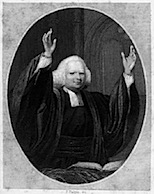 George Whitefield was Methodism’s first and most popular spokesman. Ben Franklin, one of Whitefield’s admirers, devised an experiment during one of Whitefield’s American visits to show that Whitefield could easily address 30,000 people standing in an open space. He said of Whitefield:
George Whitefield was Methodism’s first and most popular spokesman. Ben Franklin, one of Whitefield’s admirers, devised an experiment during one of Whitefield’s American visits to show that Whitefield could easily address 30,000 people standing in an open space. He said of Whitefield:
Every accent, every emphasis, every modulation of voice was so perfectly well-tuned and well-placed, that, without being interested in the subject, one could not help being pleased with the discourse; a pleasure of much the same kind with that received from an excellent piece of musick.
Why is it then that the movement that he helped co-lead with John Wesley is known as the Wesleyan Revival and not the Whitefield Revival?
Adam Clark, an early historian of Methodism, suggests the reason–a reason that is crucial to the understanding of spiritual movements.
It was by this means—the formation of small groups—that we have been enabled to establish permanent and holy churches over the world. Mr. Wesley saw the necessity of this from the beginning. Mr. Whitefield, when he separated from Mr. Wesley, did not follow it.
What was the consequence?
The fruit of Mr. Whitefield died with himself. Mr. Wesley’s fruit remains, grows, increases, and multiplies exceedingly.
Did Mr. Whitefield see his error? He did, but not till it was too late. His people, long unused to it, would not come under this discipline.
Clark then relates the following story.
Whitefield met an old friend, Mr John Pool and accosted him in the following manner:
“Well, John, art thou still a Wesleyan?”
Pool replied, “Yes, sir, and I thank God that I have the privilege of being in connection with him, and one of his preachers.”
“John,” said Whitefield, “thou art in the right place. My brother Wesley acted wisely—the souls that were awakened under his ministry he joined in class, and thus preserved the fruits of his labor. This I neglected, and my people are a rope of sand.”
By “joined in class,” Whitefield was referring to the “hierarchy of interlocking groups (societies, class meetings, bands)” that Welsey developed to “mobilize and train and disciple” the converts of his preaching. These “meetings” were the instrument by which preaching and doctrine were harnessed into spiritual renewal. It carried the revolution.
Take some time to study the following history of Wesley’s model. We can’t build movements unless we have “meetings” where disciples are transformed and leaders are multiplied.

Leave a Reply